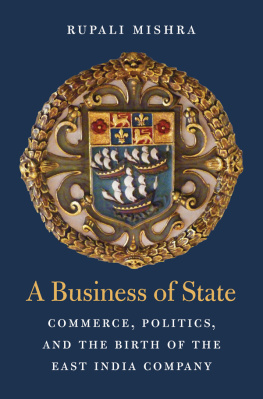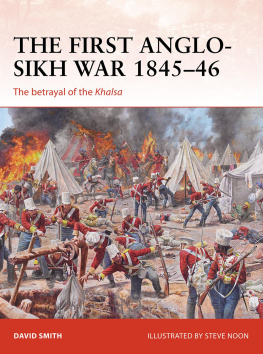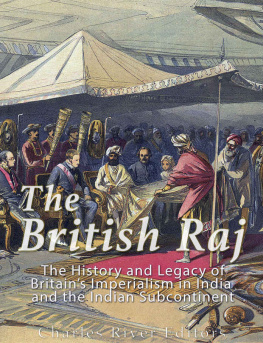CONTENTS
PASSAGES: KEY MOMENTS IN HISTORY
The East India Company, 16001858
A Short History with Documents
PASSAGES: KEY MOMENTS IN HISTORY
The East India Company, 16001858
A Short History with Documents
Ian Barrow
Hackett Publishing Company, Inc.
Indianapolis/Cambridge
Copyright 2017 by Hackett Publishing Company, Inc.
All rights reserved
Printed in the United States of America
20 19 18 2 3 4 5 6 7
For further information, please address
Hackett Publishing Company, Inc.
P.O. Box 44937
Indianapolis, Indiana 46244-0937
www.hackettpublishing.com
Cover design by Rick Todhunter
Interior design by Laura Clark
Maps by Beehive Cartography
Composition by Aptara, Inc.
Library of Congress Cataloging-in-Publication Data
Names: Barrow, Ian J., author.
Title: The East India Company, 1600/1858 : a short history with
documents / Ian Barrow.
Description: Indianapolis : Hackett Publishing Company, Inc., [2017] |
Series: Passages: Key moments in history | Includes bibliographical
references and index.
Identifiers: LCCN 2016047052 | ISBN 9781624665967 (pbk.) |
ISBN 9781624665974 (cloth)
Subjects: LCSH: East India CompanyHistory. | East India Company
HistorySources. | BritishIndiaHistorySources.
Classification: LCC DS465 .B38 2017 | DDC 382.0941/05dc23
LC record available at https://lccn.loc.gov/2016047052
epub ISBN: 978-1-62466-611-7
R. Po-chia Hsia, Matteo Ricci and the Catholic Mission to China, 1583-1610: A Short History with Documents .
CONTENTS
The page numbers in curly braces {} correspond to the print edition of this title.
{vii}
It has taken more than two years to research and write this book. My greatest debt goes to my wife, Dana, for her patience as I (endlessly) chatted about the seventeenth and eighteenth and nineteenth centuries, for her encouragement whenever I ran out of steam, and, most importantly, for her love. Along the way friends and colleagues have offered generous support and invaluable advice by reading the manuscript, discussing the ideas behind the book, or sharing their enthusiasm for the project. A heartfelt thank you to Andrew Amstutz, Febe Armanios, Michelle Baird, Hayden Bellenoit, Vivek Bhandari, Dan Brayton, Nat Caldwell, Maggie Clinton, Bo a Ergene, Philip Gould, Rebekah Irwin, Maya Joshi, Adam Lougee, Joyce Mao, Sonali Mishra, Paul Monod, Cynthia Packert, Sumathi Ramaswamy, Mark Rogers, A wadhendr a Sharan, and Kurt Suchomel. While writing the book I had my students in mind and I often shared drafts with my classes. The suggestions they offered were invariably thoughtful. Three anonymous reviewers provided detailed and helpful comments and I thank them for the considerable time they spent reading the manuscript and drafting their responses. Much of the writing was conducted while I was on sabbatical and I am grateful to Middlebury College for giving me that time. The book was first imagined in a conversation with Rick Todhunter on a cold winters afternoon in V ermont . Ever since that serendipitou s meeting, he has been an exemplary editor while his colleague Liz Wilson has expertly shepherded the book through production.
This book is dedicated to my mother, Yvonne. When I was a little boy she very often took me to visit castles, country estates, and museums spread across England and Wales. They were glorious trips, and since then she has never stopped sharing her delight in seeing and learning about the past. I could not have written this book without her love, inspiration, and encouragement.
{viii}
1600 | East India Company established |
1601 | First voyage sails for the Spice Islands |
1602 | Dutch East India Company (VOC) established The English company establishes a factory at Bantam |
1613 | Factory established at Surat |
161519 | Sir Thomas Roe travels to the Mughal court |
1623 | Amboyna massacre |
1635 | Courteens Association granted a charter by Charles I |
1639 | Factory established at Madras |
1657 | Permanent joint stock established |
1668 | Charles II transfers control over Bombay to the Company |
1685 | Bencoolen becomes new center for the export of pepper (after the Dutch expel the Company from Bantam in 1682) |
168690 | Companys war with the Mughals |
1690 | Factory established at Calcutta |
1698 | Establishment of a rival English East India company |
1709 | Merger of the two English East India companies |
1746 | Madras captured by the French |
1756 | The nawab of Bengal captures Calcutta |
1757 | Battle of Plassey |
1764 | Battle of Buxar |
1765 | The Treaty of Allahabad The defeated Mughal emperor grants the Company the diwani of Bengal and Bihar |
176669 | First Mysore War |
1772 | Height of the Companys financial and public relations crises |
1773 | Regulating Act |
{ix} 177576; 177982 | First Maratha War |
178084 | Second Mysore War |
1784 | India Act |
Establishment of the Board of Control |
1786 | Penang established |
178895 | Impeachment, trial, and eventual acquittal of Warren Hastings |
178992 | Third Mysore War |
1793 | Permanent Settlement in Bengal |
1799 | Fourth Mysore War; dissolution of the VOC |
18035 | Second Maratha War |
181718 | Third Maratha War |
1813 | The Company loses its monopoly of trade to India The Pious Clause inserted in the new charter |
1819 | Singapore established |
182326 | First Burma War |
1824 | Treaty with the Dutch results in the Dutch giving Malacca to the Company in exchange for Bencoolen |
1826 | Straits Settlements created, administratively combining Singapore, Malacca, and Penang |
1829 | Abolition of sati |
1833 | The Company loses its monopoly of trade to China and ceases commercial operations |
183942 | First Afghan War |
184546 | First Sikh War |
184849 | Second Sikh War |
185253 | Second Burma War |
1856 | Awadh annexed to Company territory |
1857 | The Rebellion in India begins |
1858 | British government replaces the Company as the government of India |
1874 |












